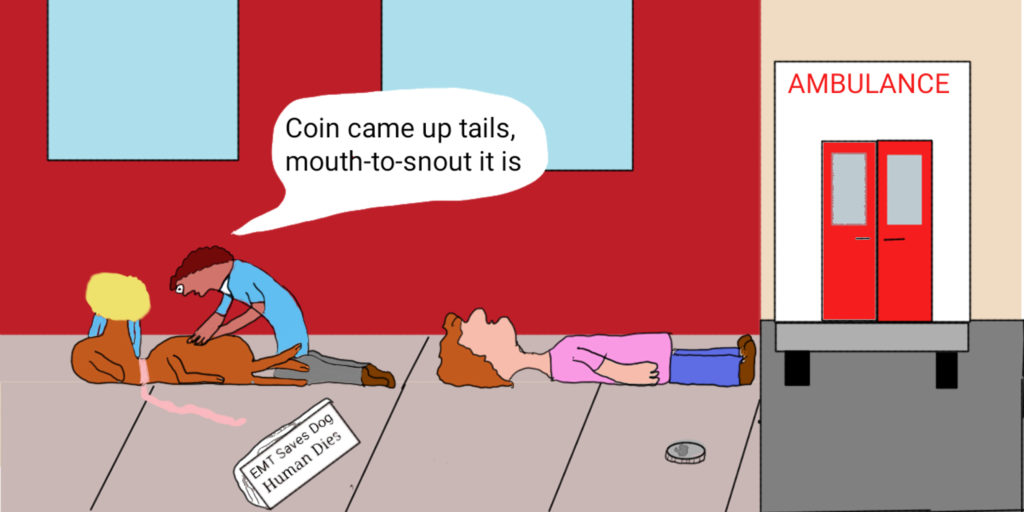by Craig Klugman, Ph.D.
Bioethics often confines itself to talking about humans and human health. Although its origins is in how human relates to the environment and there has been growing interest in environmental ethics in recent years, with the exception of serving on an IACUC and Peter Singer’s controversial ideas, bioethics does not write much about animal health. However, it is worth noting that California is considering a bill that would permit first responders to perform CPR on pets. The bill has been called “Snout to Mouth” to grab attention.
This idea is not new. The American Red Cross offers information on pet CPR (as does PetMD) and the Anti-Cruelty Society teaches classes. You can even purchase dog models to practice CPR (similar to the famous Resusci-Anne dolls used in training people on human CPR). Last year Maryland passed and Ohio enacted similar pet-CPR laws. Colorado passed their version in 2014. In 22 states, first responders can give pets CPR. In the other 28 states, such actions are illegal since it is considered practicing veterinary medicine without a license. First responders who give mouth-to-snout could be prosecuted in those jurisdictions.

In the case of California’s bill, the impetus comes from the swath of recent fires where first responders found pets in distress or unconscious. Legally, first responders should have ignored these pets, since they could be prosecuted for practicing without a license. Throughout the country, many responders have ignored these laws, often providing snout-to-mouth when needed. In Maryland and other states, the impetus is related to police dogs who can stop breathing in the course of their jobs of sniffing out drugs or explosives. A dog could inhale fentanyl or an illegal substance as almost happened in Florida. A veterinary tech on scene was able to administer naloxone since the responders legally could not.
Historically, the reason for this prohibition may have been to define animal medical treatment as the monopoly of licensed veterinarians—protecting their turf, so to speak. Ethically, the reason behind these laws may have been that first providers should treat humans first, and not our furry companions. This challenge, however, came to light during Hurricane Katrina when people were required to decide between being rescued to a shelter or staying with their pets. By adopting new rules that permitted people to keep their pets with them and planning for saving pets in the event of disasters, pets and their human companions were not separated as often during Hurricane Harvey. From a philosophical standpoint, putting people first requires what Peter Singer would call “speciesism” putting homo sapiens sapiens before other species. After all, Singer argues, there is nothing uniquely human that either does not include all humans or that does not also include some animals.
Having EMS able to give pet CPR does raise some intriguing bioethical issues. From a resource perspective, if an EMT arrives on scene where a human needs CPR and a dog needs CPR, which one should the EMT assist first (assuming that only one EMT is available)? Most people would probably respond, “the human, of course” because although we care deeply for our pets, our society still values human life over that of animals (rightly or wrongly). If we viewed both lives as equal, then perhaps the EMT should flip a coin. However, the ethics of aesthetics are probably at play in developing this prioritization since a headline that says “EMT saves human; dog dies” is less likely to be litigious than “EMT saves dog while not treating human.”
A second dilemma is whether there might be a situation where pet resuscitation is undesirable? Perhaps a house is on fire and an unconscious cat is found. Should CPR always be initiated? What if this was an elderly cat? What if the cat had cancer or suffered from end-stage renal disease? There are situations, similar to humans, where the level of suffering that CPR would inflict are worse than dying from the fire or other cause. After all, in frail humans, CPR can cause broken ribs, collapsed lung, damage to internal organs, and even if the person is resuscitated, they may have suffered hypoxic brain injury that leaves them in a vegetative state. In fact, people only survive out-of-hospital CPR 12% of the time. In animals, fewer than 6% who receive CPR in the veterinary hospital survive. Humans have the option of having an out-of-hospital DNR or a POLST (in states that have them). When my cat companion of 18-years was dying of cancer and threw a clot, I told the vet at the emergency hospital “she has a DNR and an advance directive. She [the cat] and I have been talking about this for several years now.” Where first responders offer pet-CPR, it may be important to have POLST documents for Fluffy and Spot (though legally these may not be enforceable). You may want to add a DNR dogtag (yes these are meant for people, but are available and are not too large) as part of your dog’s tags.
As a proud and happy pet dad to a senior dog and a youthful cat (yes, they do get along), I am pleased that some states permit first responders to save the lives of our beloved pets. But the bioethical issues these laws raise are real and we need to develop well-considered policies.